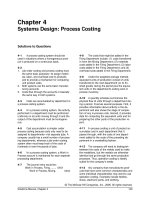Ch04 lkagtsbhhygsnkla;
Bạn đang xem bản rút gọn của tài liệu. Xem và tải ngay bản đầy đủ của tài liệu tại đây (827.82 KB, 41 trang )
<span class="text_page_counter">Trang 2</span><div class="page_container" data-page="2">
Chapter 4: Analyzing Financial Statements
</div><span class="text_page_counter">Trang 3</span><div class="page_container" data-page="3">Learning Objectives
1. Explain the three perspectives from which financial statements can be viewed.
2. Describe common-size financial statements, explain why they are used, and be able to prepare and use them to analyze the
historical performance of a firm.
</div><span class="text_page_counter">Trang 4</span><div class="page_container" data-page="4">Learning Objectives
3. Discuss how financial ratios facilitate financial analysis, and be able to compute and use
them to analyze a firm’s performance.
4. Describe the dupont system of analysis and be able to use it to evaluate a firm’s
performance and identify corrective actions that may be necessary.
</div><span class="text_page_counter">Trang 5</span><div class="page_container" data-page="5">Learning Objectives
5. Explain what benchmarks are, describe how they are prepared, and discuss why they are important in financial statement analysis.
6. Identify the major limitations in using financial statement analysis.
</div><span class="text_page_counter">Trang 6</span><div class="page_container" data-page="6">Background for Financial Statement Analysis
o <sub>PERSPECTIVES FOR ANALYSIS</sub>
<b><small>• Stockholder• Manager</small></b>
<b><small>• Creditor</small></b>
</div><span class="text_page_counter">Trang 7</span><div class="page_container" data-page="7">Background for Financial Statement Analysis
</div><span class="text_page_counter">Trang 8</span><div class="page_container" data-page="8">Background for Financial Statement Analysis
<small>increasing net cash flows</small>
<small>increasing market value of firm’s stockjob security</small>
</div><span class="text_page_counter">Trang 9</span><div class="page_container" data-page="9">Background for Financial Statement Analysis
o <sub>CREDITOR’S PERSPECTIVE</sub>
<b><small>• Focus on</small></b>
<small>predictability of revenues and expenses ability to meet short-term obligations</small>
<small>ability to make loan payments as scheduledno unanticipated change in risk </small>
</div><span class="text_page_counter">Trang 10</span><div class="page_container" data-page="10">Background for Financial Statement Analysis
<small>o</small> <sub>GUIDELINES FOR FINANCIAL STATEMENT ANALYSIS</sub>
<b><small>• Understand which perspective for: </small></b>
<b><small>stockholder, manager or creditor.</small></b>
<b><small>• Use audited financial statements.• Trend analysis (3-5 years).</small></b>
<b><small>• Compare a firm’s financial statement </small></b>
<b><small>with competitors that are the same size, products, services.</small></b>
<b><small>• Benchmark: firms compared in a same </small></b>
<small>IMPORTANT</small>
</div><span class="text_page_counter">Trang 11</span><div class="page_container" data-page="11">Common-Size Financial Statements
o <sub>COMMON-SIZE FINANCIAL STATEMENTS</sub>
<b><small>• Show the dollar amount of each </small></b>
<b><small>item as a percentage of a reference value (total assets or total revenues)</small></b>
<small>Common-size balance sheet may use total assets as the reference value; each item is expressed as a percentage of total assets.</small>
<small>Common-size income statement may use net sales as the reference value; each item is expressed as a </small>
<small>percentage of net sales.</small>
<small>.</small>
</div><span class="text_page_counter">Trang 12</span><div class="page_container" data-page="12">Common-Size Financial Statements
<small>o</small> <sub>COMMON-SIZE BALANCE SHEET</sub>
<b><small>• Standardizes the amount in a balance </small></b>
<b><small>sheet account by converting the dollar value of each item to its percentage of total assets</small></b>
<small>Dollar values on a regular balance sheet provide </small>
<small>information on the number of dollars associated with a balance sheet account.</small>
<small>Percentage values on a common-size balance sheet </small>
<small>provide information on the relative size or importance of the dollars associated with a balance sheet account.</small>
</div><span class="text_page_counter">Trang 13</span><div class="page_container" data-page="13">Exhibit 4.1: Common-Size Balance Sheets for Diaz Manufacturing
</div><span class="text_page_counter">Trang 14</span><div class="page_container" data-page="14">Exhibit 4.2: Common-Size Income Statements for Diaz Manufacturing
</div><span class="text_page_counter">Trang 15</span><div class="page_container" data-page="15">Financial Ratios and Firm Performance
<small>o</small> <sub>RATIOS IN FINANCIAL ANALYSIS. </sub>
<b><small>• Ratios establish a common reference </small></b>
<b><small>point across firms - even though the numerical value of the reference </small></b>
<b><small>point will differ from firm-to-firm</small></b>
<small>Ratios make it easier to compare the performance of large firms to that of small firms.</small>
<small>Ratios make it easier to compare the current and historical performance of a single firm as the firm changes over time.</small>
</div><span class="text_page_counter">Trang 16</span><div class="page_container" data-page="16">Financial Ratios and Firm Performance
o <sub>RATIOS USED VARY ACROSS FIRMS</sub>
<b><small>• occupancy ratios (hotel)</small></b>
<b><small>• sales-per-square foot (retailing)• loans-to-assets (banking)</small></b>
<b><small>• medical cost ratio (health </small></b>
<b><small>insurance)</small></b>
</div><span class="text_page_counter">Trang 17</span><div class="page_container" data-page="17">Financial Ratios and Firm Performance
o <sub>RATIO VALUES VARY WITHIN AN INDUSTRY</sub>
<b><small>• 2010 Gross Margin</small></b>
<small>Big LotsTarget Walmart 40.6%30.5% 24.9%</small>
</div><span class="text_page_counter">Trang 18</span><div class="page_container" data-page="18">Financial Ratios and Firm Performance
o <sub>CATEGORIES OF COMMON FINANCIAL RATIOS</sub>
</div><span class="text_page_counter">Trang 19</span><div class="page_container" data-page="19">Financial Ratios and Firm Performance
o <sub>LIQUIDITY RATIOS (SHORT-TERM SOLVENCY </sub>
<b><small>• Indicate a firm’s ability to pay </small></b>
<b><small>short-term obligations with short-short-term assets without endangering the </small></b>
<b><small>firm. In general, higher ratios are a favorable indicator.</small></b>
</div><span class="text_page_counter">Trang 20</span><div class="page_container" data-page="20">Financial Ratios and Firm Performance
<small>o</small> <sub>EFFICIENCY RATIOS</sub><b><small>• Indicate a firm’s ability to use assets to </small></b>
<b><small>produce sales. These are also called asset turnover ratios. In general, higher numbers are a favorable </small></b>
<b><small>• These ratios also are valuable for a </small></b>
<b><small>firm’s investors who use the ratios to </small></b>
<b><small>find out how quickly a firm is selling its inventory and converting receivables </small></b>
<b><small>into cash flow for investors.</small></b>
</div><span class="text_page_counter">Trang 21</span><div class="page_container" data-page="21">Financial Ratios and Firm Performance
o <sub>EFFICIENCY RATIOS</sub>
<small>(Vòng quay hàng tơn` kho)</small>
<small>(Vịng quay khoản phải thu)</small>
</div><span class="text_page_counter">Trang 22</span><div class="page_container" data-page="22">Financial Ratios and Firm Performance
o <sub>EFFICIENCY RATIOS</sub>
<b><small>• For the efficiency ratio below, a </small></b>
<b><small>lower number is generally a positive signal</small></b>
<small>(Số ngày tồn kho trung bình)</small>
<small>(Số ngày phải thu trung bình – average collection period)</small>
</div><span class="text_page_counter">Trang 23</span><div class="page_container" data-page="23">Financial Ratios and Firm Performance
o <sub>EFFICIENCY RATIOS</sub>
<small>o </small><b><small>Total asset turnover measures the dollar amount of sales generated </small></b>
<b><small>with each dollar of total assets.</small></b>
<b><small>o A common asset turnover ratio </small></b>
<b><small>(fixed asset turnover) measures sales per dollar invested in fixed assets (plant or equipment). </small></b>
</div><span class="text_page_counter">Trang 24</span><div class="page_container" data-page="24">Financial Ratios and Firm Performance
o <sub>LEVERAGE (DEBT) RATIOS </sub>
<b><small>• Indicate whether a firm is using the </small></b>
<b><small>appropriate amount of debt </small></b>
<b><small>financing. In general, higher ratios indicate greater potential return </small></b>
<b><small>and greater bankruptcy risk.</small></b>
</div><span class="text_page_counter">Trang 25</span><div class="page_container" data-page="25">Financial Ratios and Firm Performance
o <sub>LEVERAGE (DEBT) RATIOS </sub>
<b><small>• For Coverage ratios (tỷ suất năng </small></b>
<b><small>lực trả nợ), a higher number </small></b>
<b><small>generally indicates less bankruptcy risk and (possibly) lower potential return</small></b>
</div><span class="text_page_counter">Trang 26</span><div class="page_container" data-page="26">Financial Ratios and Firm Performance
o <sub>PROFITABILITY RATIOS </sub>
<b><small>• Indicate whether a firm is </small></b>
<b><small>generating adequate profit from its assets. In general, higher ratios </small></b>
<b><small>indicate better performance.</small></b>
</div><span class="text_page_counter">Trang 27</span><div class="page_container" data-page="27">Financial Ratios and Firm Performance
o <sub>PROFITABILITY RATIOS </sub>
<b><small>• Indicate whether a firm is </small></b>
<b><small>generating adequate profit from its assets. In general, higher ratios </small></b>
<b><small>indicate better performance.</small></b>
</div><span class="text_page_counter">Trang 28</span><div class="page_container" data-page="28">Financial Ratios and Firm Performance
o <sub>MARKET VALUE RATIOS </sub>
<b><small>• Indicate how the market is valuing </small></b>
<b><small>the firm’s equity. Higher ratios </small></b>
<b><small>indicate greater shareholder wealth.</small></b>
</div><span class="text_page_counter">Trang 29</span><div class="page_container" data-page="29">Diaz Manufacturing Balance Sheets as of December 31
</div><span class="text_page_counter">Trang 30</span><div class="page_container" data-page="30">Diaz Manufacturing Income Statements
</div><span class="text_page_counter">Trang 31</span><div class="page_container" data-page="31">Exhibit 4.3: Ratios for Time-Trend Analysis for Diaz Manufacturing
</div><span class="text_page_counter">Trang 32</span><div class="page_container" data-page="32">The DuPont System
<small>o</small> <sub>THE DUPONT SYSTEM</sub>
<b><small>• Diagnostic tool for evaluating a firm’s </small></b>
<b><small>financial health</small></b>
<b><small>• Uses related ratios that link the </small></b>
<b><small>balance sheet and income statement</small></b>
<b><small>• Based on two equations that connect </small></b>
<b><small>a firm’s ROA and ROE</small></b>
<b><small>• Used by management and </small></b>
<b><small>shareholders to understand factors that drive ROE</small></b>
</div><span class="text_page_counter">Trang 33</span><div class="page_container" data-page="33">The DuPont System
<b><small>• In ratio form (Equation 4.26)</small></b>
<b><small>• Shows that return-on-equity is </small></b>
<b><small>driven by profitability, operating efficiency, and amount of leverage (debt)</small></b>
</div><span class="text_page_counter">Trang 34</span><div class="page_container" data-page="34">Exhibit 4.4: Two Basic Strategies to Earn a Higher ROA
</div><span class="text_page_counter">Trang 35</span><div class="page_container" data-page="35">Exhibit 4.5: Relations in the DuPont System of Analysis
</div><span class="text_page_counter">Trang 36</span><div class="page_container" data-page="36">Selecting a Benchmark
o <sub>BENCHMARK RELEVANCE</sub>
<b><small>• A ratio or ratio analysis is relevant </small></b>
<b><small>only when compared to an appropriate benchmark</small></b>
<small>Trend Analysis – comparison to the firm’s historical performance</small>
<small>Peer Group Analysis – comparison to a select group of firms in the same industry</small>
<small>Industry Analysis – comparison to the aggregate of firms in the same industry</small>
</div><span class="text_page_counter">Trang 37</span><div class="page_container" data-page="37">Selecting a Benchmark
o <sub>BENCHMARK RELEVANCE</sub>
<b><small>• A ratio or a ratio analysis is relevant </small></b>
<b><small>only when compared to the appropriate benchmark(s). Benchmarks may be used in combination.</small></b>
<small>Level and trend should be considered when evaluating a firm’s performance and its future.</small>
</div><span class="text_page_counter">Trang 38</span><div class="page_container" data-page="38">Exhibit 4.6: Peer Group Ratios for Diaz Manufacturing
</div><span class="text_page_counter">Trang 39</span><div class="page_container" data-page="39">Exhibit 4.7: Peer Group Analysis for Diaz Manufacturing
</div><span class="text_page_counter">Trang 40</span><div class="page_container" data-page="40">Limitations of Financial Statement Analysis
o <sub>FINANCIAL STATEMENT ANALYSIS</sub><b><small>• Weaknesses</small></b>
<small>not an exact science</small>
<small>relies on accounting data and historical costs</small>
<small>few guidelines or principles for determining whether a ratio is “high” or “low”, or is a reason for confidence or for concern</small>
</div>








